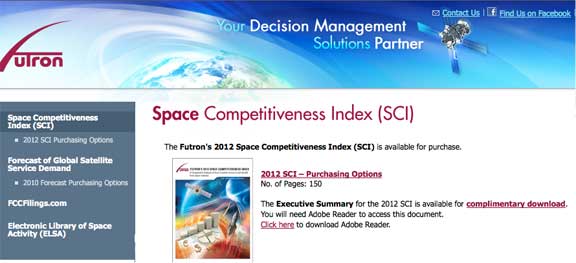...their 2012 Space Competitiveness Index: A Comparative Analysis of How Countries Invest in and Benefit from Space Industry. This report marks the fifth annual independent study of global space competitiveness. Building on prior reports, Futron’s 2012 SCI surveys five-year trends as a benchmark. It analyzes 50+ qualitative and quantitative indicators of competitiveness across three dimensions: government, human capital, and industry. Using this framework, we offer a comparative assessment of leading space-participant nations. In 2012, five new countries were added to the study:
-
· Argentina
- The United States remains the overall leader in space competitiveness, but its relative position has declined for the fifth straight year. As other countries continue to enhance their capabilities, the United States is experiencing major transitions, particularly in human spaceflight, amid uncertainty about its long-term space priorities
- Globalization of space activity is accelerating, with emerging nations quickly establishing themselves as competitors to traditional leaders. One newly added emerging nation even displaced an established leader from the group of 10 leading nations in this year’s results
- International collaboration is increasingly taking shape as a concerted space competitiveness strategy, especially among smaller actors
- Four distinct space competitiveness tiers have emerged. The top two remain dynamic, but have shown some stabilization; meanwhile, the bottom two, comprising emerging space actors, are subject to especially intense competition, with very small gaps making the difference in competitive rankings
· Australia
· Iran
· South Africa
· Ukraine
Each of these emerging nations is considered in the SCI framework alongside the 10 traditional space actors: Brazil, Canada, China, Europe (treated as a single integrated actor), India, Israel, Japan, Russia, South Korea, and the United States. Among the 2012 findings:


